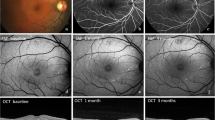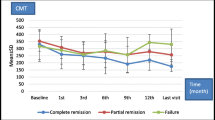Abstract
Purpose
To develop a selective micropulse individual retinal therapy (SMIRT) based on the age and appearance type of the patient, to derive a formula for calculating power, and evaluate clinical efficacy for the treatment of central serous chorioretinopathy (CSCR).
Methods
73 patients (aged 30–65 years) with acute CSCR and types 1–4 on the Fitzpatrick scale were divided into 2 groups. In the first group (33 patients), the testing of the micropulse mode (50 µs, 2.4%, 10 ms, 100 µm, 0.4–1.9 W) on the Navilas 577 s laser system defined as selective by computer modeling was performed. A logistic regression function based on probability damage detection (PDD) of the 1584 laser spots from power, age, and type on the Fitzpatrick scale was constructed. PDD is the probability of detecting the laser spots using the autofluorescence method. The second group was divided into 4 subgroups of 10 eyes each. Groups 2.1, 2.2, and 2.3 were treated without preliminary testing. The power for Groups 2.1, 2.2, and 2.3 was obtained with the inverse PDD function, so that PDD was 50%, 70%, and 90%, respectively. Control group 2.4 went without treatment.
Results
The transmission and absorption coefficients of laser radiation of the eye depend on the age and the Fitzpatrick scale type. In Groups 2.1–2.3, complete resorption of subretinal fluid was observed 3 months after CSCR treatment in 5 (P < 0.35), 8 (P < 0.023), and 10 eyes (P < 0.0008) out of 10, respectively.
Conclusion
The developed SMIRT is effective for CSCR treatment with PDD 90%.







Similar content being viewed by others
References
Schuele G, Rumohr M, Huettmann G, Brinkmann R (2005) RPE damage thresholds and mechanisms for laser exposure in the microsecond-to-millisecond time regimen. Invest Ophthalmol Vis Sci 46:714–719. https://doi.org/10.1167/iovs.04-0136
Roider J, Michaud NA, Flotte TJ, Birngruber R (1992) Response of the retinal pigment epithelium to selective photocoagulation. Arch Ophthalmol 110:1786–1792. https://doi.org/10.1001/archopht.1992.01080240126045
Roider J, Hillenkamp F, Flotte T, Birngruber R (1993) Microphotocoagulation: selective effects of repetitive short laser pulses. Proc Natl Acad Sci USA 90:8643–8647. https://doi.org/10.1073/pnas.90.18.8643
Ivanova EV, Volodin PL, Guskov AV (2022) Determination of micropulse modes with targeted damage to the retinal pigment epithelium using computer modeling for the development of selective individual micropulse retinal therapy. Curr Eye Res 47:107–114. https://doi.org/10.1080/02713683.2021.1962360
Wang J, Quan Y, Dalal R, Palanker D (2017) Comparison of continuous-wave and micropulse modulation in retinal laser therapy. Invest Ophthalmol Vis Sci 58:4722–4732. https://doi.org/10.1167/iovs.17-21610
Lavinsky D, Wang J, Huie P et al (2016) Nondamaging retinal laser therapy: rationale and applications to the macula. Investigative Opthalmol Vis Sci 57:2488. https://doi.org/10.1167/iovs.15-18981
Volodin PL, Ivanova EV, Solomin V (2018) The possibilities of modern diagnostic methods and computer data processing using the FemtoScan program to identify weak thermal damage of retinal pigment epithelium cells. Laser Med 1:52–57
Volodin PL, Ivanova EV (2020) Clinical evaluation of individualized and navigated microsecond pulsing laser for acute central serous chorioretinopathy. Ophthalmic Surg Lasers Imaging Retina 51:512–520. https://doi.org/10.3928/23258160-20200831-06
Volodin PL, Doga AV, Ivanova EV et al (2019) The personalized approach to the chronic central serous chorioretinopathy treatment based on the navigated micropulse laser technology. Ophthalmol Russia 15:394–404. https://doi.org/10.18008/1816-5095-2018-4-394-404
Hammer M, Schweitzer D (2002) Quantitative reflection spectroscopy at the human ocular fundus. Phys Med Biol 47:179–191. https://doi.org/10.1088/0031-9155/47/2/301
Shu X, Liu W, Zhang HF (2015) Monte Carlo investigation on quantifying the retinal pigment epithelium melanin concentration by photoacoustic ophthalmoscopy. J Biomed Opt 20:106005. https://doi.org/10.1117/1.jbo.20.10.106005
Geeraets W, Williams R, Chan G et al (1962) The relative absorption of thermal energy in retina and choroid. Invest Ophthalmol Vis Sci 1:340–347
Fitzpatrick TB (1988) The validity and practicality of sun-reactive skin types I through VI. Arch Dermatol 124:869–871. https://doi.org/10.1001/archderm.124.6.869
He SY, McCulloch CE, Boscardin WJ et al (2014) Self-reported pigmentary phenotypes and race are significant but incomplete predictors of Fitzpatrick skin phototype in an ethnically diverse population. J Am Acad Dermatol 71:731–737. https://doi.org/10.1016/j.jaad.2014.05.023
Sarna T, Burke JM, Korytowski W et al (2003) Loss of melanin from human RPE with aging: possible role of melanin photooxidation. Exp Eye Res 76:89–98. https://doi.org/10.1016/S0014-4835(02)00247-6
Weale RA (1988) Age and the transmittance of the human crystalline lens. J Physiol 395:577–587. https://doi.org/10.1113/jphysiol.1988.sp016935
Gawęcki M (2015) Increase in central retinal edema after subthreshold diode micropulse laser treatment of chronic central serous chorioretinopathy. Case Rep Ophthalmol Med 2015:1–4. https://doi.org/10.1155/2015/813414
Scholz P, Altay L, Fauser S (2017) A review of subthreshold micropulse laser for treatment of macular disorders. Adv Ther 34:1528–1555. https://doi.org/10.1007/s12325-017-0559-y
Gawęcki M (2019) Micropulse laser treatment of retinal diseases. J Clin Med 8:242. https://doi.org/10.3390/jcm8020242
Ohkoshi K, Tsuiki E, Kitaoka T, Yamaguchi T (2010) Visualization of subthreshold micropulse diode laser photocoagulation by scanning laser ophthalmoscopy in the retro mode. Amer J Ophthalmol 150. https://doi.org/10.1016/j.ajo.2010.06.022
Luttrull JK, Sramek C, Palanker D et al (2012) Long-term safety, high-resolution imaging, and tissue temperature modeling of subvisible diode micropulse photocoagulation for retinovascular macular edema. Retina 32:375–386. https://doi.org/10.1097/IAE.0b013e3182206f6c
Zhou L, Lai K, Jin L, et al (2021) Subthreshold micropulse laser vs. conventional laser for central serous chorioretinopathy: a randomized controlled clinical trial. Front Med 8. https://doi.org/10.3389/fmed.2021.682264
Maltsev DS, Kulikov AN, Chhablani J (2019) Clinical application of fluorescein angiography-free navigated focal laser photocoagulation in central serous chorioretinopathy. Ophthalmic Surg Lasers Imaging Retina 50:E118–E124. https://doi.org/10.3928/23258160-20190401-16
Maruko I, Koizumi H, Hasegawa T, et al (2017) Subthreshold 577 nm micropulse laser treatment for central serous chorioretinopathy. PLoS One 12. https://doi.org/10.1371/journal.pone.0184112
Ambiya V, Goud A, Mathai A et al (2016) Microsecond yellow laser for subfoveal leaks in central serous chorioretinopathy. Clin Ophthalmol 10:1513–1519. https://doi.org/10.2147/OPTH.S112431
Lanzetta P, Furlan F, Morgante L et al (2008) Nonvisible subthreshold micropulse diode laser (810 nm) treatment of central serous chorioretinopathy. A pilot study. Eur J Ophthalmol 18:934–940. https://doi.org/10.1177/112067210801800613
Luttrull JK (2016) Low-intensity/high-density subthreshold diode micropulse laser for central serous chorioretinopathy. Retina 36:1658–1663. https://doi.org/10.1097/IAE.0000000000001005
Kim YJ, Lee YG, Lee DW, Kim JH (2018) Selective retina therapy with real-time feedback-controlled dosimetry for treating acute idiopathic central serous chorioretinopathy in Korean patients. J Ophthalmol 2018. https://doi.org/10.1155/2018/6027871
Elsner H, Pörksen E, Klatt C et al (2006) Selective retina therapy in patients with central serous chorioretinopathy. Graefe’s Arch Clin Exp Ophthalmol 244:1638–1645. https://doi.org/10.1007/s00417-006-0368-5
Kim YJ, Kim SY, Ha S, Moon D, Seong S, Kwon OW, Park HS (2019) Short-duration multiple-session subthreshold micropulse yellow laser (577 nm) for chronic central serous chorioretinopathy: results at 3 years. Eye (Lond). 33(5):819-825. https://doi.org/10.1038/s41433-018-0309-7.
Author information
Authors and Affiliations
Corresponding author
Ethics declarations
Ethical approval
All procedures performed in this study were in accordance with the tenets of the Declaration of Helsinki 1964 and its amendments. This study was approved by the Institutional Review Board: Interuniversity Ethics Committee (Protocol 11).
Informed consent
All patients provided written consent and were informed of the surgical procedures beforehand, including the testing phase that was performed to determine the personalized parameters for the treatment.
Conflict of interest
The authors declare no competing interests.
Additional information
Publisher's note
Springer Nature remains neutral with regard to jurisdictional claims in published maps and institutional affiliations.
Presented virtually at the Association for Research in Vision and Ophthalmology (ARVO) May 2-6, 2021, San Francisco, CA, USA .
This article received support from the mentorship team. Further information can be found in the editorial https://link.springer.com/article/10.1007/s00417-019-04518-5.
Rights and permissions
Springer Nature or its licensor holds exclusive rights to this article under a publishing agreement with the author(s) or other rightsholder(s); author self-archiving of the accepted manuscript version of this article is solely governed by the terms of such publishing agreement and applicable law.
About this article
Cite this article
Ivanova, E.V., Volodin, P.L. Development of the selective micropulse individual retinal therapy depends on age and type on the Fitzpatrick scale. Graefes Arch Clin Exp Ophthalmol 261, 381–390 (2023). https://doi.org/10.1007/s00417-022-05800-9
Received:
Revised:
Accepted:
Published:
Issue Date:
DOI: https://doi.org/10.1007/s00417-022-05800-9




